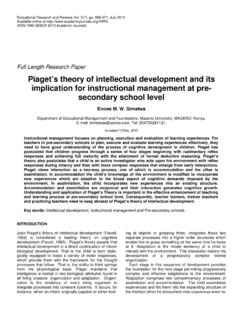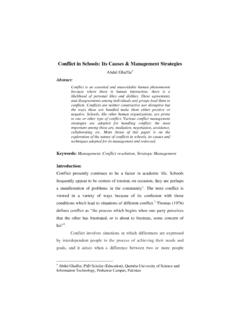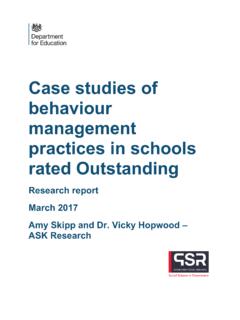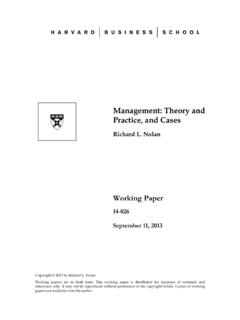Transcription of Example secondary school anti-bullying policy
1 Example OF AN anti-bullying policy FOR secondary SCHOOLS Example policy anti-bullying policy anti-bullying policy Approved by the Governing Body Date Headteacher: Signed: Chair of Governors: Signed: Statement of intent The aim of the anti-bullying policy is to ensure that pupils learn in a supportive, caring and safe environment without fear of being bullied. Bullying is anti-social behaviour and affects everyone; it is unacceptable. We are committed to providing a caring, friendly and safe environment for all of our pupils so they can learn in a relaxed and secure atmosphere. If bullying does occur, all pupils should be able to tell and know that incidents will be dealt with promptly and effectively.
2 Why do we need an anti-bullying policy ? Persistent bullying can severely inhibit a child s ability to learn effectively. The negative effects of bullying can have an impact on a person for their entire life. This school wishes to promote a secure and happy environment free from threat, harassment and any type of bullying behaviour. Therefore this policy promotes practices within the school to reinforce our vision, and to remove or discourage practices that negate them. What is Bullying? Bullying occurs when an individual or a group uses strength or power to hurt, either physically or emotionally, by intimidating or demeaning others.
3 Bullying can be emotional, physical, racist, homophobic, biphobic, transphobic, verbal or cyber. It is usually persistent and is often covert, and is a conscious attempt to hurt, threaten or frighten someone. Pupils who are being bullied, may show changes in behaviour, such as becoming shy and nervous, feigning illness, taking unusual absences or clinging to adults. There may be evidence of changes in work patterns, lacking concentration or truanting from school . Bullying can take many forms including: Physical bullying which can include kicking, hitting, pushing and taking away belongings; Verbal bullying which includes name calling, mocking and making offensive comments; Emotional bullying which includes isolating an individual or spreading rumours about them; Cyber-bullying where technology is used to hurt an individual for instance text messaging or posting messages/images on the internet or any form of social media Racist bullying occurs when bullying is motivated by racial, ethnic or cultural prejudice.
4 Sexual bullying is where someone makes unwanted physical contact or makes sexually abusive comments. Homophobic and biphobic bullying occurs when bullying is motivated by a prejudice against lesbian, gay or bisexual people. Transphobic bullying occurs when bullying is motivated by a prejudice against people who identify as trans Disablist bullying occurs when bullying is motivated by a prejudice against people with any form of disability. Sexist bullying occurs when bullying is motivated by a prejudice against someone because of their gender With the advance in new technologies, school is aware there is an increased risk of cyber bullying using e-mails, instant messenger, social networking sites, and public websites inappropriately.
5 Therefore our school has an ICT user s policy which all students and parents sign, along with a separate E-Safety policy . Some warning signs that a student is being bullied Changes in academic performance Appears anxious Regularly feeling sick or unwell. Wanting to visit the nurse regularly. Reluctance to come to school . Clothes/bags torn or damaged. Money/possessions going missing. Unexplained cuts and bruises. Unexplained behaviour changes, moody, bad-tempered, tearful. Unhappiness. Loss of appetite. Not sleeping. Loss of weight Seen alone a lot Not very talkative Some reasons why people bully Desire to appear powerful Unhappiness Feelings of inadequacy Difficulties at home.
6 Learned behaviour (They too have been bullied) How to get help Who students can talk to if they have any concerns about bullying? Form tutor Year Leader Subject teacher Mentor Peer Support group Subject Leader Leadership Group Learning Support Assistant school Nurse Education welfare Officer Office staff Students can feel confident that any of the above will listen to their problem. Pupils who have been bullied will be supported by: 1. Offering an immediate opportunity to discuss the experience with a form tutor or member of staff of their choice 2. Reassuring the pupil 3. Offering continuous support 4.
7 Restoring self-esteem and confidence Pupils who have bullied will be helped by: 1. Discussing what happened 2. Discovering why the pupil became involved 3. Establishing the wrong doing and need to change 4. Informing parents or guardians to help change the attitude of the pupil Responses will vary depending on the nature of the incident, but may include: 1. Counselling 2. Use of a report card 3. Involvement of external agencies 4. Monitoring by Tutor/Head of Year 5. Peer support/peer mentoring 6. Formal recording (racism, hbt) 7. Use of Behaviour Agreement Contract 8. Liaison with parents/guardian/social worker 9. Internal exclusion 10.
8 Fixed term exclusion 11. Permanent exclusion Anti Bullying Procedures It is made clear that bullying in any form is unacceptable. It will be taken seriously and dealt with promptly Staff Responsibilities To implement procedures to confront bullying in any form To listen to all parties involved in incidents To investigate incidents promptly and as fully as possible To take appropriate action or to refer to Tutor/Head of Year/SMT as appropriate To record in the appropriate students files and in the racist/HBT (homophobic, biphobic, transphobic) record if appropriate To share with parents of the victim and bully, incidents of persistent and/or serious bullying To implement appropriate procedures for a member of staff To promote the use of a range of learning styles and strategies which challenge bullying behaviour To promote open management styles which facilitate communication and consultation within the school and relevant outside agencies when appropriate To model the values our school believes in from the mission statement To promote the use of interventions which are least intrusive and most effective.
9 Anti Bullying Strategies Regular promotion of anti bullying in assemblies. Use of CCTV within the school grounds to help with the prevention of bullying. A duty rota for staff so they patrol key areas before school , break, lunchtime and after school Annual questionnaires to research student views on how safe they feel in school Self esteem and circle time work in the school s inclusion facilities Anti bullying training for the Pastoral Leaders PSHC lessons on anti bullying A special e-mail address to report any incidents of bullying One to one counselling from a trained sixth form team available every lunchtime Strong teacher-student relationships so students feel comfortable in reporting any issues Information talks from the school Police Liaison Officer CEOP training for staff (Child exploitation online protection)
10 Information leaflet for students and parents about E-Safety anti-bullying advice to Parents / Carers A great deal of bullying is CYBER-BULLYING. Please regularly monitor your child s use of texting, Facebook, Twitter and other social media sites. Access to these is out of the schools control when your child is not in school TALK to your child on a regular basis, so any problem is easier to share LISTEN to what they say ENCOURAGE your child to feel good about themselves, realising that we are all different and equally important If you believe your child is being bullied, or is a bully, talk to other adults at home or at school and explore the options.







